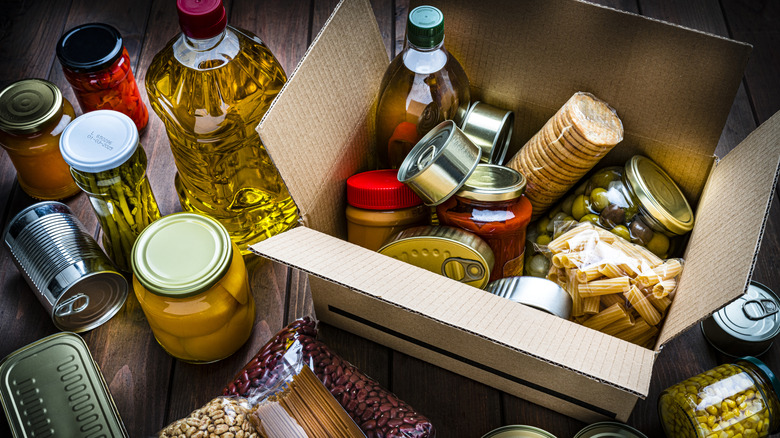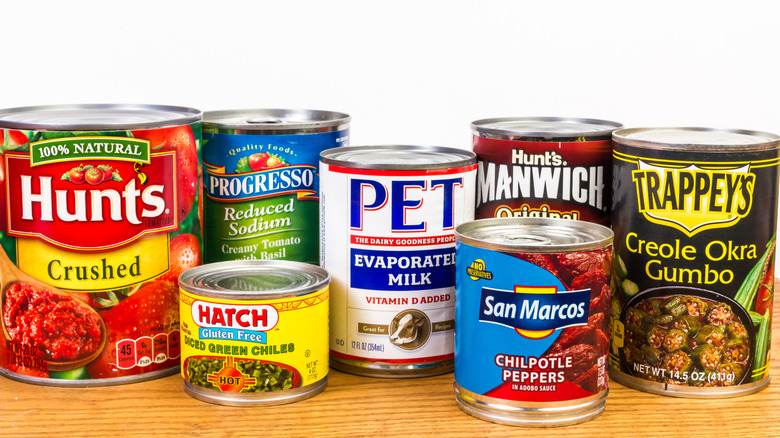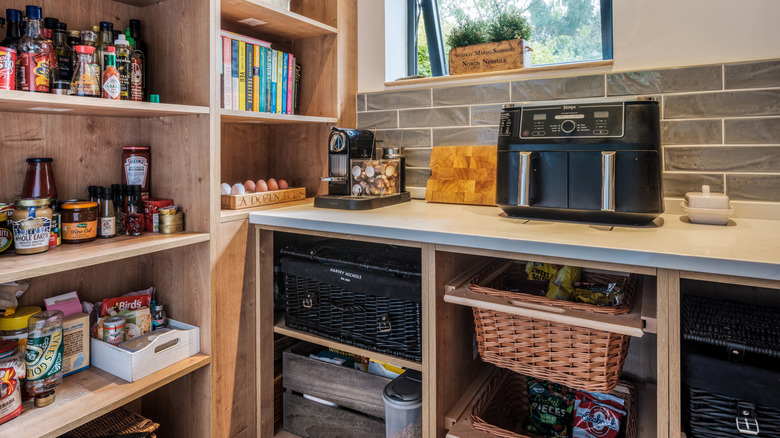Is There A More Efficient Way To Store Canned Goods In The Pantry?
We may receive a commission on purchases made from links.
Aside from the jars of spaghetti sauce and big tubs of peanut butter, your pantry probably contains a lot of cans, stacked one on top of the other — and ready to get knocked over with an errant swipe of the hand. While it doesn't have to look like an aesthetic, Instagram-worthy pantry, you should — for health and safety reasons! — find a more efficient method of storing your cans, at least. And one of the easiest ways to give your canned goods a utilitarian face-lift is to use organizers.
There are tons of inexpensive pantry organizers on the market these days (if you're on a budget) in a variety of models, from clear bins to pantry risers, lazy Susans, and even sloped wire racks — just like at the grocery store. We're partial to the latter three: the risers, because you can see just enough of each label to know what you've got hidden in the back, and the lazy Susans, because then there technically is no "back" to the pantry (it's all a matter of perspective). But the wire racks, like these ones from Kitchen Details, make especially good use of vertical space while also giving you an easier time viewing everything you have in stock.
Tips for organizing your cans
Once you have your organizers set up, you can begin placing your cans back in the pantry — but wait, you don't want to just stick them back in any old order. A great way to keep on top of what you have in stock, as well as how much of a certain item you have, is to group your cans by type (it's one of Ina Garten's kitchen organization tips, after all).
Now, it's totally up to you how you decide to do this, but you could keep your vegetables and fruits separate, then group fruits by kind. Vegetables could also be kept together by type, then sub-type (for example, tomatoes in one organizer, with crushed tomatoes on one tier, diced tomatoes on another, and tomato paste on a third). If you do this, chances are good you won't end up with 12 cans of the exact same crushed tomatoes.
Another thing you can do to keep your cans safe and intact is to rotate your collection based on expiration or best-by dates. Chefs call it the FIFO rule — FIFO standing for "first in, first out." Assuming the most recently purchased cans have the latest expiration dates (not always, though, so it's worth checking), they should go to the back of the pantry, while the oldest cans should be rotated forward for earliest use.
How to store cans to maximize shelf-life
Efficiency isn't just measured by how easy your cans are to read or see; it also has to do with how long they last you, so you aren't having to throw them out continuously. Some cans read that you should store them in a "cool, dry place" — for many homes, that is the pantry. But if, for some reason, yours is near heat-expelling appliances like your fridge or stove/oven — or even water pipes or heating vents — you might want to consider keeping cans in another dry location, like a spare bedroom closet or even your basement (so long as it's not damp). And if you have cupboards near these appliances, you shouldn't keep your cans in those, either.
Now, there is another dimension to why we like the wire racks so much for can organization — because they provide plenty of space for air to flow between everything. When cans are kept close together — like when they are stacked on the floor — there is little ventilation. Heat can build up, with moisture to follow, causing rust, which can introduce microscopic holes into the cans, allowing bacteria to enter and contaminate the food inside. If you have closed organizers, at least don't overfill them, and try to keep your cans spaced out a little so air can circulate around them.



